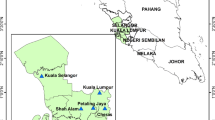Abstract
Exposure to high levels of pollution is a persistent problem in large cities throughout the world. The ability to predict the occurrence of a high level of a pollutant allows environmental authorities to take preventive measures, such as controlling the emission of pollution. Communities and officials can also take actions to reduce the exposure of susceptible groups in the population. Therefore, being able to estimate the behavior of a given pollutant is of great importance. In this article we use a Markov chain model to study this behavior. In order to do so, we consider the sequence of the daily maximum measurements of a pollutant and let successive intervals containing them follow a Markov chain of order K>-0. The novelty here is that we allow K to be a random variable and estimate it and the corresponding transition probabilities using a maximum a posteriori method. The results are used to perform estimations about the behavior of ozone levels in Mexico City.
Similar content being viewed by others
References
Álvarez, L. J., Garcia, N. L., and Rodrigues, E. R. (2003), “The Performance of a Reversible Jump Markov Chain Monte Carlo Algorithm for DNA Sequences Alignment,” Publicationes Preliminares, 765, Instituto de Matemáticas, Universidad Nacional Autónoma de México.
Austin, J., and Tran, H. (1999), “A Characterization of the Weekday-Weekend Behavior of Ambient Ozone Concentrations in California,” in Air Pollution VII, Southampton: WIT Press, pp. 645–661.
Boys, R. J., and Henderson, D. A. (2002), “On Determining the Order of Markov Dependence of an Observed Process Governed by a Hidden Markov Model,” Special Issue of Scientific Programming, 10, 241–251.
Boys, R. J., and Henderson, D. A. (2003), “Bayesian Approach to DNA Segmentation,” to appear in Biometrics.
Boys, R. J., Henderson, D. A., and Wilkinson, D. J. (2000), “Detecting Homogeneous Segments in DNA Sequences by Using Hidden Markov Models,” Applied Statistics, 49, 269–285.
Churchill, G. A., and Lazareva, B. (1999), “Bayesian Restoration of a Hidden Markov Chain with Applications to DNA Sequencing,” Journal of Computational Biology, 6, 261–277.
Dacunha-Castelle, D., and Dulfo, M. (1986), Probability and Statistics—Vol. II, New York: Springer-Verlag.
Evans, M., and Swartz, T. (2000), Approximating Integrals via Monte Carlo and Deterministic Methods, Oxford: Oxford Statistical Sciences Series 20, Oxford University Press.
Fan, T.-H., and Tsai, C.-A. (1999), “A Bayesian Method in Determining the Order of a Finite State Markov Chain, Communications in Statistics—Theory and Methods, 28, 1711–1730.
Ferrari, P. A., Frigessi, A., and Gonzaga de Sá, P. G. (1995), “Fast Approximate Maximum a posteriori Restoration of Multicolour Images,” Journal of the Royal Statistical Society, Series B, 57, 485–500.
Flaum, J. B., Rao, S. T., and Zurbenko, I. G. (1996), “Moderating Infuence of Meteorological Conditions on Ambient Ozone Concentrations,” Journal of Air and Waste Management Association, 46, 33–46.
Geman, D. (1990), “Random Fields and Inverse Problems in Imaging,” Lecture Notes in Mathematics, 1427, New York: Springer-Verlag, pp. 113–193.
Guardani, R., Nascimento, C. A. O., Guardani, M. L. G., Martins, M. H. R. B., and Romano, J. (1999), “Study of Atmospheric Ozone Formation by Means of a Neural Network Based Model,” Journal of the Air and Waste Management Association, 49, 316–323.
Guardani, R., Aguiar, J. L., Nascimento, C. A. O., Lacava, C. I. V. and Yanagi, Y. (2003), “Ground-Level Ozone Mapping in Large Urban Areas using Multivariate Analysis: Application to the São Paulo Metropolitan Area, Journal of the Air and Waste Management Association, 53, 553–559.
Horowitz, J. (1980), “Extreme Values From a Nonstationary Stochastic Process: An Application to Air Quality Analysis,” Technometrics, 22, 469–482.
INE (2003), Segundo Almanaque de Datos y Tendencias de la Calidad del Aire en seis Ciudades Mexicanas, Instituto Nacional de Ecología, Secretaría de Medio Ambiente y Recursos Naturales, México, (www.ine.gob.mx/ueajei/publicaciones/index.html).
Larsen, L. C., Bradley, R. A., and Honcoop, G. L. (1990), “A New Method of Characterizing the Variability of Air Quality-Related Indicators,” Air and Waste Management Association’s International Specialty Conference of Tropospheric Ozone and the Environment, Los Angeles, CA.
Loomis, D. P., Borja-Arbuto, V. H., Bangdiwala, S. I., and Shy, C. M. (1996), “Ozone Exposure and Daily Mortality in Mexico City: A Time Series Analysis,” Health Effects Institute Research Report, 75, 1–46.
NOM (2002), “Modificación a la Norma Oficial Mexicana NOM-020-SSA1-1993,” Diario Oficial de la Federación, 30 de Octubre de 2002.
Smith, R. L. (1989), “Extreme Value Analysis of Environmental Time Series: An Application to Trend Detection in Ground-Level Ozone,” Statistical Sciences, 4, 367–393.
Author information
Authors and Affiliations
Corresponding author
Rights and permissions
About this article
Cite this article
Álvarez, L.J., Fernández-Bremauntz, A.A., Rodrigues, E.R. et al. Maximum a posteriori estimation of the daily ozone peaks in Mexico City. JABES 10, 276–290 (2005). https://doi.org/10.1198/108571105X59017
Received:
Revised:
Issue Date:
DOI: https://doi.org/10.1198/108571105X59017




